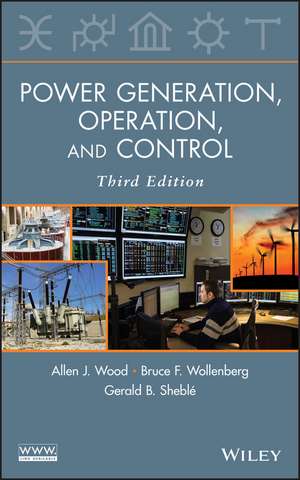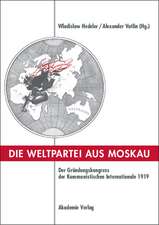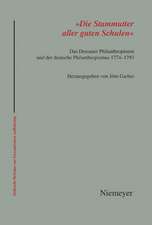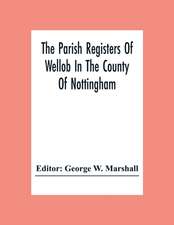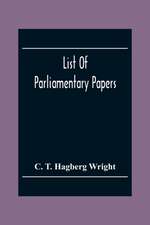Power Generation, Operation and Control, Third Edition
Autor AJ Wooden Limba Engleză Hardback – 23 dec 2013
Preț: 870.10 lei
Preț vechi: 1191.92 lei
-27% Nou
Puncte Express: 1305
Preț estimativ în valută:
166.49€ • 173.83$ • 137.79£
166.49€ • 173.83$ • 137.79£
Carte tipărită la comandă
Livrare economică 04-18 aprilie
Preluare comenzi: 021 569.72.76
Specificații
ISBN-13: 9780471790556
ISBN-10: 0471790559
Pagini: 656
Dimensiuni: 156 x 234 x 36 mm
Greutate: 1.02 kg
Ediția:3rd Edition
Editura: Wiley
Locul publicării:Hoboken, United States
ISBN-10: 0471790559
Pagini: 656
Dimensiuni: 156 x 234 x 36 mm
Greutate: 1.02 kg
Ediția:3rd Edition
Editura: Wiley
Locul publicării:Hoboken, United States
Public țintă
Professionals, graduate students, regulators and consultantsNotă biografică
ALLEN J. WOOD joined Power Technologies, Inc., in 1969 as a Principal Engineer and Director. He was a Life Fellow of IEEE and served as an adjunct professor in the Electric Power Engineering graduate program at Rensselaer Polytechnic Institute. Dr. Wood passed away in 2011. BRUCE F. WOLLENBERG joined the University of Minnesota in 1989 and made original contributions to the understanding of electric power market structures. He is a Life Fellow of the IEEE and a member of the National Academy of Engineering. GERALD B. SHEBLÉ joined Auburn University in 1990 to conduct research in power system, space power, and electric auction market research. He joined Iowa State University to conduct research in the interaction of markets and power system operation. His academic research has continued to center on the action of the markets based on the physical operation of the power system. He is a Fellow of the IEEE.
Cuprins
Preface to the Third Edition xvii Preface to the Second Edition xix Preface to the First Edition xxi Acknowledgment xxiii 1 Introduction 1 1.1 Purpose of the Course / 1 1.2 Course Scope / 2 1.3 Economic Importance / 2 1.4 Deregulation: Vertical to Horizontal / 3 1.5 Problems: New and Old / 3 1.6 Characteristics of Steam Units / 6 1.7 Renewable Energy / 22 APPENDIX 1A Typical Generation Data / 26 APPENDIX 1B Fossil Fuel Prices / 28 APPENDIX 1C Unit Statistics / 29 References for Generation Systems / 31 Further Reading / 31 2 Industrial Organization, Managerial Economics, and Finance 35 2.1 Introduction / 35 2.2 Business Environments / 36 2.3 Theory of the Firm / 40 2.4 Competitive Market Solutions / 42 2.5 Supplier Solutions / 45 2.6 Cost of Electric Energy Production / 53 2.7 Evolving Markets / 54 2.8 Multiple Company Environments / 58 2.9 Uncertainty and Reliability / 61 PROBLEMS / 61 Reference / 62 3 Economic Dispatch of Thermal Units and Methods of Solution 63 3.1 The Economic Dispatch Problem / 63 3.2 Economic Dispatch with Piecewise Linear Cost Functions / 68 3.3 LP Method / 69 3.4 The Lambda Iteration Method / 73 3.5 Economic Dispatch Via Binary Search / 76 3.6 Economic Dispatch Using Dynamic Programming / 78 3.7 Composite Generation Production Cost Function / 81 3.8 Base Point and Participation Factors / 85 3.9 Thermal System Dispatching with Network Losses Considered / 88 3.10 The Concept of Locational Marginal Price (LMP) / 92 3.11 Auction Mechanisms / 95 APPENDIX 3A Optimization Within Constraints / 106 APPENDIX 3B Linear Programming (LP) / 117 APPENDIX 3C Non-Linear Programming / 128 APPENDIX 3D Dynamic Programming (DP) / 128 APPENDIX 3E Convex Optimization / 135 PROBLEMS / 138 References / 146 4 Unit Commitment 147 4.1 Introduction / 147 4.2 Unit Commitment Solution Methods / 155 4.3 Security-Constrained Unit Commitment (SCUC) / 167 4.4 Daily Auctions Using a Unit Commitment / 167 APPENDIX 4A Dual Optimization on a Nonconvex Problem / 167 APPENDIX 4B Dynamic-Programming Solution to Unit Commitment / 173 4B.1 Introduction / 173 4B.2 Forward DP Approach / 174 PROBLEMS / 182 5 Generation with Limited Energy Supply 187 5.1 Introduction / 187 5.2 Fuel Scheduling / 188 5.3 Take-or-Pay Fuel Supply Contract / 188 5.4 Complex Take-or-Pay Fuel Supply Models / 194 5.5 Fuel Scheduling by Linear Programming / 195 5.6 Introduction to Hydrothermal Coordination / 202 5.7 Hydroelectric Plant Models / 204 5.8 Scheduling Problems / 207 5.9 The Hydrothermal Scheduling Problem / 211 5.10 Hydro-Scheduling using Linear Programming / 222 APPENDIX 5A Dynamic-Programming Solution to hydrothermal Scheduling / 225 5.A.1 Dynamic Programming Example / 227 PROBLEMS / 234 6 Transmission System Effects 243 6.1 Introduction / 243 6.2 Conversion of Equipment Data to Bus and Branch Data / 247 6.3 Substation Bus Processing / 248 6.4 Equipment Modeling / 248 6.5 Dispatcher Power Flow for Operational Planning / 251 6.6 Conservation of Energy (Tellegen's Theorem) / 252 6.7 Existing Power Flow Techniques / 253 6.8 The Newton-Raphson Method Using the Augmented Jacobian Matrix / 254 6.9 Mathematical Overview / 257 6.10 AC System Control Modeling / 259 6.11 Local Voltage Control / 259 6.12 Modeling of Transmission Lines and Transformers / 259 6.13 HVDC links / 261 6.14 Brief Review of Jacobian Matrix Processing / 267 6.15 Example 6A: AC Power Flow Case / 269 6.16 The Decoupled Power Flow / 271 6.17 The Gauss-Seidel Method / 275 6.18 The "DC" or Linear Power Flow / 277 6.19 Unified Eliminated Variable Hvdc Method / 278 6.20 Transmission Losses / 284 6.21 Discussion of Reference Bus Penalty Factors / 288 6.22 Bus Penalty Factors Direct from the AC Power Flow / 289 PROBLEMS / 291 7 Power System Security 296 7.1 Introduction / 296 7.2 Factors Affecting Power System Security / 301 7.3 Contingency Analysis: Detection of Network Problems / 301 7.4 An Overview of Security Analysis / 306 7.5 Monitoring Power Transactions Using "Flowgates" / 313 7.6 Voltage Collapse / 315 APPENDIX 7A AC Power Flow Sample Cases / 327 APPENDIX 7B Calculation of Network Sensitivity Factors / 336 7B.1 Calculation of PTDF Factors / 336 7B.2 Calculation of LODF Factors / 339 7B.3 Compensated PTDF Factors / 343 Problems / 343 References / 349 8 Optimal Power Flow 350 8.1 Introduction / 350 8.2 The Economic Dispatch Formulation / 351 8.3 The Optimal Power Flow Calculation Combining Economic Dispatch and the Power Flow / 352 8.4 Optimal Power Flow Using the DC Power Flow / 354 8.5 Example 8A: Solution of the DC Power Flow OPF / 356 8.6 Example 8B: DCOPF with Transmission Line Limit Imposed / 361 8.7 Formal Solution of the DCOPF / 365 8.8 Adding Line Flow Constraints to the Linear Programming Solution / 365 8.9 Solution of the ACOPF / 368 8.10 Algorithms for Solution of the ACOPF / 369 8.11 Relationship Between LMP, Incremental Losses, and Line Flow Constraints / 376 8.12 Security-Constrained OPF / 382 APPENDIX 8A Interior Point Method / 391 APPENDIX 8B Data for the 12-Bus System / 393 APPENDIX 8C Line Flow Sensitivity Factors / 395 APPENDIX 8D Linear Sensitivity Analysis of the AC Power Flow / 397 PROBLEMS / 399 9 Introduction to State Estimation in Power Systems 403 9.1 Introduction / 403 9.2 Power System State Estimation / 404 9.3 Maximum Likelihood Weighted Least-Squares Estimation / 408 9.4 State Estimation of an Ac Network / 421 9.5 State Estimation by Orthogonal Decomposition / 428 9.6 An Introduction to Advanced Topics in State Estimation / 435 9.7 The Use of Phasor Measurement Units (PMUS) / 447 9.8 Application of Power Systems State Estimation / 451 9.9 Importance of Data Verification and Validation / 454 9.10 Power System Control Centers / 454 APPENDIX 9A Derivation of Least-Squares Equations / 456 9A.1 The Overdetermined Case (Nm > Ns) / 457 9A.2 The Fully Determined Case (Nm = Ns) / 462 9A.3 The Underdetermined Case (Nm PROBLEMS / 464 10 Control of Generation 468 10.1 Introduction / 468 10.2 Generator Model / 470 10.3 Load Model / 473 10.4 Prime-Mover Model / 475 10.5 Governor Model / 476 10.6 Tie-Line Model / 481 10.7 Generation Control / 485 PROBLEMS / 497 References / 500 11 Interchange, Pooling, Brokers, and Auctions 501 11.1 Introduction / 501 11.2 Interchange Contracts / 504 11.3 Energy Interchange between Utilities / 517 11.4 Interutility Economy Energy Evaluation / 521 11.5 Interchange Evaluation with Unit Commitment / 522 11.6 Multiple Utility Interchange Transactions--Wheeling / 523 11.7 Power Pools / 526 11.8 The Energy-Broker System / 529 11.9 Transmission Capability General Issues / 533 11.10 Available Transfer Capability and Flowgates / 535 11.11 Security Constrained Unit Commitment (SCUC) / 550 11.12 Auction Emulation using Network LP / 555 11.13 Sealed Bid Discrete Auctions / 555 PROBLEMS / 560 12 Short-Term Demand Forecasting 566 12.1 Perspective / 566 12.2 Analytic Methods / 569 12.3 Demand Models / 571 12.4 Commodity Price Forecasting / 572 12.5 Forecasting Errors / 573 12.6 System Identification / 573 12.7 Econometric Models / 574 12.8 Time Series / 578 12.9 Time Series Model Development / 585 12.10 Artificial Neural Networks / 603 12.11 Model Integration / 614 12.12 Demand Prediction / 614 12.13 Conclusion / 616 PROBLEMS / 617 Index 620
